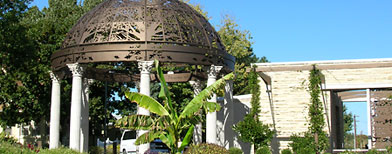The Daily Drift
Today's horoscope says:
Not everyone is as comfortable with change as you are.
Be very mindful of that fact when new ideas shake up your group today.
Some folks may freak out a little bit -- and they may have trouble making sense of it all.
Try to convince these people that new ideas are nothing to be afraid of.
Suggest that they take a 'wait and see' attitude about things, and remind them that all the transitions that are coming won't be happening overnight.
Be very mindful of that fact when new ideas shake up your group today.
Some folks may freak out a little bit -- and they may have trouble making sense of it all.
Try to convince these people that new ideas are nothing to be afraid of.
Suggest that they take a 'wait and see' attitude about things, and remind them that all the transitions that are coming won't be happening overnight.
Some of our readers today have been in:
Berlin, Berlin, Germany
Auckland, Auckland, New Zealand
Canberra, Australian Capital Territory, Australia
Rome, Lazio, Italy
Gengenbach, Baden-Wurttemberg, Germany
Dublin, Dublin, Ireland
Paris, Ile-De-France, France
Munich, Bayern, Germany
Hamburg, Hamburg, Germany
Sydney, New South Wales, Australia
Groningen, Groningen, Netherlands
Bilbao, Pais Vasco, Spain
Edinburgh, Scotland, United Kingdom
Perth, Western Australia, Australia
Vancouver, British Columbia, Canada
Calgary, Alberta, Canada
Trail, British Columbia, Canada
Surrey, British Columbia, Canada
Toronto, Ontario, Canada
Sofia, Sofyia, Bulgaria
Montreal, Quebec, Canada
Bath, England, United Kingdom
Melbourne, Victoria, Australia
Granada, Andalucia, Spain
Brisbane, Queensland, Australia
Den Haag, Zuid-Holland, Netherlands
London, England, United Kingdom
Bangalore, Karnataka, India
Kuala Lumpur, Wilayah Persekutuan, Malaysia
Newbury, England, United Kingdom
Zurich, Zurich, Switzerland
Enschede, Overijssel, Netherlands
Woking, England, United Kingdom
Rivine, Rivnens'ka Oblast, Ukraine
Regina, Sasketchewan, Canada
Berlin, Berlin, Germany
Auckland, Auckland, New Zealand
Canberra, Australian Capital Territory, Australia
Rome, Lazio, Italy
Gengenbach, Baden-Wurttemberg, Germany
Dublin, Dublin, Ireland
Paris, Ile-De-France, France
Munich, Bayern, Germany
Hamburg, Hamburg, Germany
Sydney, New South Wales, Australia
Groningen, Groningen, Netherlands
Bilbao, Pais Vasco, Spain
Edinburgh, Scotland, United Kingdom
Perth, Western Australia, Australia
Vancouver, British Columbia, Canada
Calgary, Alberta, Canada
Trail, British Columbia, Canada
Surrey, British Columbia, Canada
Toronto, Ontario, Canada
Sofia, Sofyia, Bulgaria
Montreal, Quebec, Canada
Bath, England, United Kingdom
Melbourne, Victoria, Australia
Granada, Andalucia, Spain
Brisbane, Queensland, Australia
Den Haag, Zuid-Holland, Netherlands
London, England, United Kingdom
Bangalore, Karnataka, India
Kuala Lumpur, Wilayah Persekutuan, Malaysia
Newbury, England, United Kingdom
Zurich, Zurich, Switzerland
Enschede, Overijssel, Netherlands
Woking, England, United Kingdom
Rivine, Rivnens'ka Oblast, Ukraine
Regina, Sasketchewan, Canada
Hanover, Niedersachsen, Germany
as well as Slovakia, Malta, Bulgaria, Israel, Finland, Austria, Norway, Georgia, Mexico, Peru, Kuwait, Serbia, Bangladesh, Latvia, Greece, Scotland, Hong Kong, Denmark, Wales, Iran, Singapore, Poland, Taiwan, Sweden, Afghanistan, Belgium, Tibet, Croatia, Pakistan, Romania, Paraguay, Sudan, Vietnam, Argentina, Cambodia, Egypt, France, Estonia, Puerto Rico, Maldives, Qatar, Brazil, New Zealand, United Arab Emirates, Slovenia, China, Iraq, Ecuador, Nigeria, Colombia, Chile, Honduras, Paupa New Guinea, Moldova, Venezuela, Germany, Mexico, Saudi Arabia, Ireland, Czech Republic, Vietnam, Norway, Finland
and in cities across the United States such as Front Royal, Hyde Park, Spanish Fork, Stone Mountain
and more!
and in cities across the United States such as Front Royal, Hyde Park, Spanish Fork, Stone Mountain
and more!
Today is:
Today is Monday, November 14, the 318th day of 2011.
There are 47 days left in the year.
Today's unusual holiday or celebration is:
National American Teddy Bear Day.
Don't forget to visit our sister blog!









 An Yashi, a professor at Sinchuan University in China, has produced tea which is fertilized with panda droppings. At $80,000 per kilogram, it’ll be the most expensive tea in the world when it reaches the market. Yashi claims that it’s worth the price because of special health benefits:
An Yashi, a professor at Sinchuan University in China, has produced tea which is fertilized with panda droppings. At $80,000 per kilogram, it’ll be the most expensive tea in the world when it reaches the market. Yashi claims that it’s worth the price because of special health benefits:


















 Endangered birds arrive in the UK
Endangered birds arrive in the UK Afraid of spiders? Maybe it’s because of all those stories you’ve heard about their creepy ways. Some of those stories hold no water, according to science writer Kim Hosey. She’s got a good list of busted spider myths.
Afraid of spiders? Maybe it’s because of all those stories you’ve heard about their creepy ways. Some of those stories hold no water, according to science writer Kim Hosey. She’s got a good list of busted spider myths. Shrimp has 'silk-spinning skills'
Shrimp has 'silk-spinning skills'
